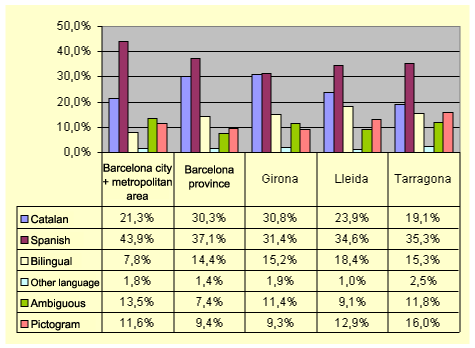








 |

 |
 |
|
Sociolingüística catalana |
 |
 |
CONTINUA |
 |
Conversations between the researcher and
the cashier and/or person in charge took place in Catalan in 42% of the establishments,
this being initiated in Catalan by the service personnel in half of all cases. Overall,
almost 37% of employees did not spontaneously address their customers in Catalan. In many
self-service establishments the use of Catalan is non-existent, it being anticipated that
this mode of service will increase.
Figure 2:
Language use by province General overview

Source: Language in service stations in Catalonia. Sociolinguistic
contribution. 2000
From a territorial perspective, the
presence of Spanish more than doubles that of Catalan in the Barcelona region (44%
Spanish, 21% Catalan), and shows almost the same result in the comarcas of
Tarragona (35% Spanish, 19% Catalan). The predominance of Spanish lessens in the comarcas
to the west of Barcelona province and tends to even out in the provinces of Girona, with
percentages of around 31% for both Spanish and Catalan. Bilingualism is notable in the
Lleida comarcas (18%) with slightly higher percentages than those for Tarragona,
Girona and the Barcelona comarcas. Signage and messages transmitted in an ambiguous
way are most common in the city and metropolitan area of Barcelona (14%). In Tarragona, on
the other hand, the use of pictograms is noteworthy (16%) as compared to other provinces.
If we compare the various company brands
with language uses, we see that petrol companies can be divided into three groups
displaying different behavioural types. First, we have the group comprising the heirs of
the old State monopoly, who use Spanish as the main language in 40% or more of their
signage. In a best-case scenario, use of Catalan is reduced to around 20%. While Cepsa
puts forward an image strongly in favour of bilingualism, Campsa and Petronor tend towards
Spanish, and rarely resort to bilingualism. Secondly, we have the group made up of the
multinational petrol companies of European and North American origin; these apply a
certain de facto bilingualism and, with the exception of BP, Catalan appears in
almost all cases as the predominant language of the two. Finally, Petrocat distinguishes
itself from the others by its extensive use of Catalan, and thus forms a separate
grouping. In the cases of Agip, Total and Shell, there are a greater number of signs,
posters and warnings in Catalan than Spanish.
In order to refine the sociolinguistic
analysis of the sector somewhat, the research team created three benchmark figures for the
use of Catalan over the whole sector. The first refers to the extensive use of Catalan in
the content of 22 signs, and shows that in one out of four service stations Catalan does
not appear. The second analyses the use of Catalan in internal written paperwork between
service stations and their respective petrol companies. Catalan is equally absent in this
linguistic area in 74% of cases. In the third case, the verbal use of Catalan in service
stations in communication between the employee and the researcher is evaluated, as we have
seen. Looking at this last case, there is an evident improvement in the position held by
Catalan in an area which is obviously far less formal.
In conclusion, we can state that the
presence of the Catalan language in the fuel sector is still fairly precarious as far as
signage, posters, notices and internal communication between employees and their supplier
or owner company is concerned. We use the word "still" deliberately, it being
understood that by complying with current legislation in force and implementing some of
the many proposals raised by this research, it should, in the short term, be possible to
influence the process of linguistic use in the whole sector, towards the Catalan language
occupying a much more important – or even exclusive – place within the corporate
dynamic. This is despite the apathy inherited from the whole process of privatising the
sector, which continues to have a negative effect with regard to the Catalan language,
especially over the whole system of signage, posters, advertising and on relationships
determined by business models based on high levels of corporate organisational
centralisation. In our opinion, special attention needs to be given to the excessive
tendency for linguistic ambiguity, which could well reflect a process of uniformity that
may be linguistic at the present time but which could easily lead to political and
cultural uniformity at a later date. |
|
|

